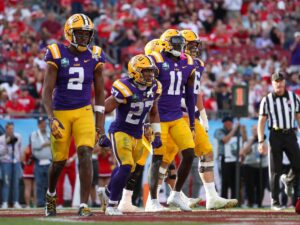
Dan Campbell’s Bold Stand: A Strong Message to the NFL on the Tush Push and Jalen Hurts’ Eagles
In the ever-evolving world of the NFL, innovation is as crucial to a team’s success as the fundamentals of blocking, tackling, and scheming. Over the last few seasons, the Philadelphia Eagles have become the poster child for innovation, particularly with their infamous “Tush Push” play, which has become one of the most discussed and controversial strategies in the league. But while the Eagles’ success with the play has certainly raised eyebrows and brought them closer to the pinnacle of the NFL, not everyone is on board with its effectiveness, legality, and impact on the game.
Among those voicing their concerns is Detroit Lions head coach Dan Campbell, whose candid remarks at a recent NFL meeting have sparked a wide-reaching conversation about the future of the Tush Push in the league. Known for his brash and direct style, Campbell didn’t mince words when addressing the issue, calling out the Eagles’ success and delivering a powerful message to the NFL. His comments are not just about a specific play but are reflective of a larger concern about the direction of the league, player safety, and the potential future of strategic innovation.
The Tush Push, a play that has been in the NFL for decades, rose to prominence in the 2022 and 2023 seasons largely due to the Eagles’ success with quarterback Jalen Hurts. It’s a short-yardage play in which the quarterback is pushed forward by his teammates, often resulting in a near-automatic conversion on third or fourth down. While the concept is not entirely new, the Eagles, with their powerful offensive line and the dynamic running of Hurts, have perfected it, making it nearly impossible to stop.
The play, though, has drawn plenty of criticism. Some argue that it is a blatant exploitation of the league’s current rules, claiming that it is a form of illegal “push,” while others simply view it as an unfair advantage, one that makes the game less competitive and less about individual skill. For many, including Campbell, this is not just an aesthetic problem; it is a potential safety issue.
Campbell’s comments at the NFL meeting reflect his growing concerns. “It’s not football as we know it,” he stated during the heated exchange. “This isn’t about athleticism or strategy anymore; it’s about getting a guy pushed into a pile and hoping for the best. It’s a dangerous play, and it’s starting to set a precedent that I don’t think we want to follow as a league.”
While Campbell’s remarks may sound extreme to some, they resonate with the underlying tension in the NFL between preserving traditional elements of the game and embracing new strategies that challenge the status quo. The Eagles’ success with the Tush Push has sparked a wider debate about the role of power football and brute strength in a league that has historically prioritized speed, agility, and finesse.
One of the key elements of Campbell’s criticism is the play’s impact on player safety. He pointed out that the Tush Push, while seemingly harmless, increases the risk of injury due to the nature of the pile-up that typically occurs during the play. As players are bunched together and pushed forward, there is the potential for awkward collisions, leading to knee, ankle, and back injuries. For a coach like Campbell, who is known for his emphasis on physical toughness but also player welfare, these concerns are not easily dismissed.
“I think we’re kidding ourselves if we don’t acknowledge that this is a dangerous play,” Campbell continued. “You can say what you want about pushing the pile, but what happens when a guy twists an ankle or takes a knee to the head in one of those scrums? It’s an injury waiting to happen. We need to think long-term about the health of our players.”
The debate over the Tush Push is emblematic of a broader trend in the NFL in which rule changes and the evolution of the game can often place player safety in a difficult balance with fan entertainment and strategic innovation. Over the years, the league has instituted a series of rules designed to protect players from high-impact collisions, especially in the open field, but plays like the Tush Push seem to circumvent those efforts by emphasizing power over precision.
This isn’t the first time Campbell has voiced his concerns about the direction of the NFL. As a head coach who embodies the old-school ideals of the game—grit, toughness, and physicality—Campbell has often made waves with his opinions. His direct approach to leadership has earned him respect, but it also places him in a position to challenge the status quo, especially when it comes to matters of player health.
“We’re starting to see more and more players get hurt, and we’ve got to be cautious about what we’re allowing,” Campbell said. “I get that the Eagles have found a way to make it work, but there are things we need to address before it becomes a trend.”
The Eagles, of course, have defended the Tush Push, arguing that it’s simply a well-executed play that takes advantage of the current rules of the game. Jalen Hurts has become the face of the play, with his ability to power through defenders and muscle his way forward in short-yardage situations making him one of the most efficient quarterbacks in the league on these plays. The Eagles’ offensive line, arguably one of the best in the NFL, plays a huge role in executing the play, creating an almost insurmountable wall of protection for Hurts to push forward.
For the Eagles, the Tush Push has been a game-changer, allowing them to convert critical third- and fourth-down situations with remarkable success. But despite the effectiveness of the play, Campbell’s concerns speak to a larger issue in the NFL: the potential consequences of unchecked innovation. The Tush Push may be the first play to ignite this conversation, but if it becomes a widely adopted strategy, it could alter the way the game is played, potentially making it more about brute force and less about skill and strategy.
While the league hasn’t yet taken any major steps to outlaw or modify the Tush Push, Campbell’s words have certainly added fuel to the fire. The NFL Competition Committee is expected to address the issue in the coming months, and the debate is unlikely to subside anytime soon. If the league decides to ban or modify the play, it would likely be a huge shift, both in terms of strategy and the future of short-yardage situations.
Campbell, for his part, has been clear that he’s not opposed to strategic innovation or the pursuit of excellence on the field. What he’s concerned about is the long-term health of the game and the players who make it all possible. “We need to protect the integrity of the game,” he said. “That means keeping it safe, keeping it fair, and making sure that players aren’t put in situations where they’re at risk for injury just to gain a yard or two.”
As the debate over the Tush Push continues, Campbell’s bold stance is sure to resonate with many within the NFL who are concerned about the game’s future. Whether or not the league will take action remains to be seen, but one thing is certain: Campbell’s message is a wake-up call to the NFL and the wider football community about the need to balance innovation with the well-being of the players who make the game great. For now, the conversation around the Tush Push is far from over, and as long as Campbell is on the sidelines, it’s clear that he won’t back down from voicing his opinion on what’s best for the game.





